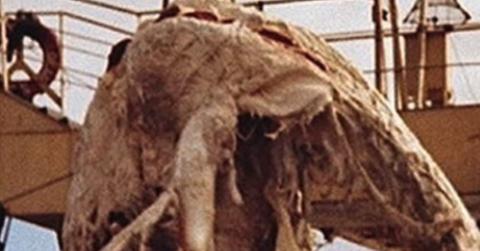Fishermen Dredged Up Sea Monster Nicknamed 'Nessie' off New Zealand Coast — but Tossed 30-Foot Carcass Overboard Because of Stench

A photo of the sea-borne dinosaur-like carcass.
A crew aboard a Japanese fishing boat got a little bit more than they bargained for when they dredged up the corpse of a 30-foot sea creature.
Knewz.com reported that the carcass weighing a staggering 3,968 pounds had the fishermen convinced they stumbled upon a modern-day dinosaur.
According to the Daily Star, the finding took place east of Christchurch in New Zealand, aboard the Japanese trawler Zuiyo Maru in 1977. The find was followed by excitement as the fishermen thought they had found an unidentified animal of potential biological significance.
However, due to the foul stench emanating from the rotting carcass, the captain, Akira Tanaka, decided to return it to the ocean, so as not to spoil the fish they had already caught - but not before photographs and samples were taken for later analysis.
The creature, nicknamed Nessie, possessed distinct features, including a long neck, four large red-colored fins, and a 2-meter-long tail. It was noted that the chest cavity contained no internal organs, and the gut had opened up due to decay. Nevertheless, flesh and fat remained intact, allowing for the extraction of amino acids for examination.
The discovery caused a frenzy in Japan, giving rise to what became known as the "plesiosaur craze."
Many scientists, including those from Yokohama and Tokyo University, believed that the creature resembled a sea serpent or a prehistoric plesiosaur, a species that had perished alongside the dinosaurs 65 million years ago.
In fact so large was the craze that the shipping company went so far as to order all its vessels to search for the dumped carcass, but their efforts were in vain.
Despite the widespread enthusiasm not everyone was convinced. Hans-Christian Bjerring, a Swedish paleontologist, expressed skepticism and suggested that microscopic analysis of the fins and skin samples taken from the creature would have provided a conclusive answer.
"If it's true that the Japanese collected samples of fins and skin, it would be possible to conclude from a microscope what it is."
"If it would be shown to be a hitherto unknown animal from the sea," his analyses continued, "it is as big of a sensation as the discovery of the coelacanth in 1938… but there is reason to be suspicious of the claims of plesiosaurs, for example, as the marine environment and fauna changed drastically since the age of the plesiosaurs on earth.”
Never miss a story — sign up for the Front Page Detectives newsletter. Be on the scene the moment news breaks.
Notably, there is no record of such an examination.
As time went on, scientists eventually concluded that the identity of the carcass could not be definitively determined.
However, many agreed that it was most likely that of a basking shark or a closely related species. Decomposing basking shark carcasses often lose their lower head area and dorsal and caudal fins first after they die, resulting in a resemblance to plesiosaurs.
Become a Front Page Detective
Sign up to receive breaking
Front Page Detectives
news and exclusive investigations.
